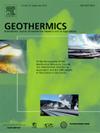Geochemical and isotopic constraints on thermal waters around the Gulf of Edremit, western Türkiye
IF 3.5
2区 工程技术
Q3 ENERGY & FUELS
引用次数: 0
Abstract
The Edremit pull-apart basin located on the southern branch of the North Anatolian Fault System hosts the Güre, Edremit, and Ayvalık geothermal areas. The graben faults that form the basin are regions of high hydraulic conductivity and contribute to the deep circulation of thermal water. In this study, the chemical and isotopic characteristics of thermal and cold waters in these fields are investigated by using the major ion and trace element contents as well as environmental isotope compositions. The Güre and Edremit thermal waters are of Na-SO4 and Na-SO4-HCO3 type and Ayvalık thermal waters are represented by Na-HCO3 composition. One of the thermal waters in the Ayvalık field is likely to experience seawater intrusion. The diversity in the chemical composition and temperature of the studied thermal waters is explained by a combination of processes including mixing of the thermal water with cold groundwater, feldspar dissolution and ion exchange in clayey rocks. Results of environmental isotope analyses indicate that the Ayvalık waters have a shallower circulation and are recharged from elevations lower than Edremit and Güre waters. The Karakaya formation and volcanic rocks comprise the recharge area of Ayvalık waters whereas Kazdağ group rocks and granites are the major lithologies exposing on the recharge area of Güre and Edremit fields. Since quartz geothermometers yield temperatures less than 190 °C, silica concentration in waters is controlled by the chalcedony phase. Reservoir temperatures estimated by the chalcedony geothermometer are 79–96 °C for Güre waters, 64–73 °C for the Edremit waters and 48–54 °C for the Ayvalık waters. Cation geothermometers yield temperatures that are significantly higher than the silica geothermometers, 65–126 °C, 65–117 °C and 38–99 °C for the respective fields. Mineral equilibrium calculations indicate that all waters show undersaturation with respect to sulfate minerals (anhydrite and gypsum) and chalcedony.
挪威西部Edremit湾周围热水体的地球化学和同位素约束
Edremit拉分盆地位于北安那托利亚断裂系统的南部分支,拥有g re, Edremit和Ayvalık地热区。形成盆地的地堑断裂是高导水率的区域,有利于热水的深层循环。本研究利用主要离子和微量元素含量以及环境同位素组成研究了这些地区冷热水体的化学和同位素特征。g re和Edremit热水以Na-SO4和Na-SO4- hco3类型为主,Ayvalık热水以Na-HCO3组成为代表。Ayvalık油田的其中一处热水可能发生海水入侵。研究的热水在化学成分和温度上的差异可以用热水与冷地下水的混合、长石溶解和粘土岩石中的离子交换等综合过程来解释。环境同位素分析结果表明,Ayvalık水体具有较浅的环流,并从低于Edremit和g re的海拔补充。Karakaya组和火山岩构成Ayvalık水补给区,kazdaerdogan组岩石和花岗岩是g re和Edremit油田补给区暴露的主要岩性。由于石英地温计产生的温度低于190℃,水中的二氧化硅浓度由玉髓相控制。利用玉髓地温计估算的储层温度为:g re水体79 ~ 96℃,Edremit水体64 ~ 73℃,Ayvalık水体48 ~ 54℃。阳离子地温计产生的温度明显高于二氧化硅地温计,分别为65-126°C, 65-117°C和38-99°C。矿物平衡计算表明,所有水域的硫酸盐矿物(硬石膏和石膏)和玉髓均呈欠饱和状态。
本文章由计算机程序翻译,如有差异,请以英文原文为准。
求助全文
约1分钟内获得全文
求助全文
来源期刊

Geothermics
工程技术-地球科学综合
CiteScore
7.70
自引率
15.40%
发文量
237
审稿时长
4.5 months
期刊介绍:
Geothermics is an international journal devoted to the research and development of geothermal energy. The International Board of Editors of Geothermics, which comprises specialists in the various aspects of geothermal resources, exploration and development, guarantees the balanced, comprehensive view of scientific and technological developments in this promising energy field.
It promulgates the state of the art and science of geothermal energy, its exploration and exploitation through a regular exchange of information from all parts of the world. The journal publishes articles dealing with the theory, exploration techniques and all aspects of the utilization of geothermal resources. Geothermics serves as the scientific house, or exchange medium, through which the growing community of geothermal specialists can provide and receive information.
 求助内容:
求助内容: 应助结果提醒方式:
应助结果提醒方式:


